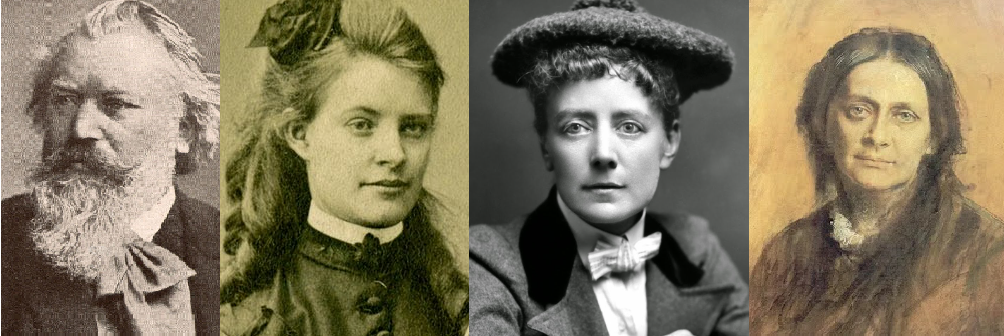Two Germans, a Brit and a Swede walk into a Leipzig salon – sounds like the beginning of a bad joke doesn’t it? In this month’s Hidden Herstory article we explore the work of four composers –Amanda Maier, Ethel Smyth, Clara Schumann and Johannes Brahms, whose lives intersected in late 19th century Leipzig. All four knew each other, collaborated on performances, influenced great work and enjoyed long friendships. Please permit me the pleasure of introducing these composers and highlighting the various connections between them. Sources consulted and music mentioned is listed below.

Amanda Maier (1853-1894)
The first woman to graduate from the Swedish Royal Academy of Music with a Director of Music diploma, violinist and composer Amanda Maier contributed many fantastic violin pieces to the repertoire, and also toured all through Europe and ran a popular salon in Amsterdam. In 1876 she premiered her own violin concerto, later performing it as soloist with the Gewandhaus Orchestra. Two years later Maier completed her fabulous Violin Sonata in B Minor, in 1878, one year before Johannes Brahms wrote his own Violin Sonata No.1 in G Major Op. 78, possibly inspired by Maier. Brahms’ Violin Concerto formed part of Amanda Maier’s repertoire, as did his third Violin Sonata, Op. 108, for which Brahms sought Maier’s advice, proving a mutual influence and reciprocal inspiration existed.
Johannes Brahms first met Amanda Maier during her studies in Leipzig, at the home of Maier’s teacher Engelbert Röntgen. This home sat at the heart of the city’s musical life and his family held regular musical gatherings. The attendees of these salons included the most popular and influential musicians of the time, including Clara Schumann, Brahms and Edvard Grieg. There Amanda Maier would also meet Ethel Smyth, beginning a warm and valued correspondence.
Ethel Smyth (1868-1944)
A composer known for her grand late Romantic scores, Ethel Smyth studied at the Leipzig Conservatory in 1877, then privately with another of Maier’s friends, Heinrich von Herzegonberg. Smyth became friendly with him and his wife, through them meeting both Maier and Brahms. Smyth adored Brahms’ music, considering it the apotheosis of all. Brahms later became her friend and mentor in Leipzig, although she despised his sexist traits. Ethel Smyth also idolised Clara Schumann from a young age and relished the opportunity to meet her. On October 24, 1878, Ethel Smyth thrillingly reported attending a gala concert celebrating Clara Schumann’s 50th anniversary as a concert pianist, Smyth even kissing the hand of the great woman!
Clara Schumann (1819-1896)
Dominating the musical scene in Leipzig, Germany, and indeed Europe throughout the 19th century, Clara Schumann played an important role as friend, mentor, inspiration and collaborator to many younger artists. After initially boarding with Clara and her husband, Johannes Brahms and Clara Schumann maintained a lifelong friendship. Clara premiered and performed innumerable works by Brahms, including his Piano Concerto No. 1 (modelled on Clara’s own from two decades prior, see our previous blog here), Piano Sonata No. 1 and Rhapsody in G Minor. Brahms in turn dedicated several pieces to Clara over the years, including his Piano Sonata No. 2, and 6 Klavierstucke. Not only a great inspiration, Clara exerted a massive influence on Brahms’ career: her championing of his works and frequent performances cemented his stature as a great composer. After Brahms sent Amanda Maier his D minor Violin Sonata in 1888, she performed the work with Clara Schumann the following year, in what must have been a glorious collaboration and wonderful occasion. Clara later added the work to her performance repertoire.
I hope this article has thrown back the veil covering several of the women in Brahms’ circle, showcasing their incredible work and great importance during the Romantic period in Germany. For further information please find the bibliography below and performance materials.
References
Album Liner Notes: Dame Ethel Smyth: Songs and Ballads by Lucy Stevens and Christopher Wiley (2020)
Dissertation: Amanda Maier: Her Life and Career as a Nineteenth-Century Woman Violinist by Jennifer Martyn (2018)
Website: Swedish Musical Heritage – Amanda Maier biography by Eva Öhrström (2013) translated by Roger Fanner
Website: Schumann-Portal.De
Performance materials
Amanda Maier – Violin Concerto in D Minor Score & Parts
Amanda Maier – Violin Sonata in B Minor Score & Parts
Ethel Smyth – The Wreckers Score & Parts
Clara Schumann – Piano Concerto Score & Parts
